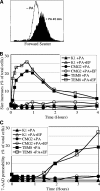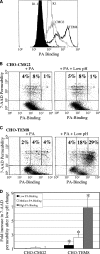Toxicity of anthrax toxin is influenced by receptor expression
- PMID: 18596206
- PMCID: PMC2546661
- DOI: 10.1128/CVI.00103-08
Toxicity of anthrax toxin is influenced by receptor expression
Abstract
Anthrax toxin protective antigen (PA) binds to its cellular receptor, and seven subunits self-associate to form a heptameric ring that mediates the cytoplasmic entry of lethal factor or edema factor. The influence of receptor type on susceptibility to anthrax toxin components was examined using Chinese hamster ovary (CHO) cells expressing the human form of one of two PA receptors: TEM8 or CMG2. Unexpectedly, PA alone, previously believed to only mediate entry of lethal factor or edema factor, was found to be toxic to CHO-TEM8 cells; cells treated with PA alone displayed reduced cell growth and decreased metabolic activity. PA-treated cells swelled and became permeable to membrane-excluded dye, suggesting that PA formed cell surface pores on CHO-TEM8 cells. While CHO-CMG2 cells were not killed by wild-type PA, they were susceptible to the PA variant, F427A. Receptor expression also conferred differences in susceptibility to edema factor.
Figures







Similar articles
-
Selection of anthrax toxin protective antigen variants that discriminate between the cellular receptors TEM8 and CMG2 and achieve targeting of tumor cells.J Biol Chem. 2007 Mar 30;282(13):9834-9845. doi: 10.1074/jbc.M611142200. Epub 2007 Jan 24. J Biol Chem. 2007. PMID: 17251181 Free PMC article.
-
Anthrax Toxin Protective Antigen Variants That Selectively Utilize either the CMG2 or TEM8 Receptors for Cellular Uptake and Tumor Targeting.J Biol Chem. 2016 Oct 14;291(42):22021-22029. doi: 10.1074/jbc.M116.753301. Epub 2016 Aug 23. J Biol Chem. 2016. PMID: 27555325 Free PMC article.
-
The receptors that mediate the direct lethality of anthrax toxin.Toxins (Basel). 2012 Dec 27;5(1):1-8. doi: 10.3390/toxins5010001. Toxins (Basel). 2012. PMID: 23271637 Free PMC article.
-
T cell targeting by anthrax toxins: two faces of the same coin.Toxins (Basel). 2011 Jun;3(6):660-71. doi: 10.3390/toxins3060660. Epub 2011 Jun 20. Toxins (Basel). 2011. PMID: 22069732 Free PMC article. Review.
-
Interactions between anthrax toxin receptors and protective antigen.Curr Opin Microbiol. 2005 Feb;8(1):106-12. doi: 10.1016/j.mib.2004.12.005. Curr Opin Microbiol. 2005. PMID: 15694864 Review.
Cited by
-
Anthrax Protective Antigen 63 (PA63): Toxic Effects in Neural Cultures and Role in Gulf War Illness (GWI).Neurosci Insights. 2020 Jun 30;15:2633105520931966. doi: 10.1177/2633105520931966. eCollection 2020. Neurosci Insights. 2020. PMID: 32656531 Free PMC article.
-
Efficacy of Single and Combined Antibiotic Treatments of Anthrax in Rabbits.Antimicrob Agents Chemother. 2015 Dec;59(12):7497-503. doi: 10.1128/AAC.01376-15. Epub 2015 Sep 21. Antimicrob Agents Chemother. 2015. PMID: 26392505 Free PMC article.
-
Anthrax Edema and Lethal Toxins Differentially Target Human Lung and Blood Phagocytes.Toxins (Basel). 2020 Jul 20;12(7):464. doi: 10.3390/toxins12070464. Toxins (Basel). 2020. PMID: 32698436 Free PMC article.
-
Negative Association of Gulf War Illness Symptomatology with Predicted Binding Affinity of Anthrax Vaccine Antigen to Human Leukocyte (HLA) Class II Molecules.Vaccines (Basel). 2025 Jan 18;13(1):88. doi: 10.3390/vaccines13010088. Vaccines (Basel). 2025. PMID: 39852867 Free PMC article.
-
Human Leukocyte Antigen (HLA) at the Root of Persistent Antigens and Long COVID.J Immunol Sci. 2025 Jan 6;9(1):1-3. doi: 10.29245/2578-3009/2025/1.1257. J Immunol Sci. 2025. PMID: 39949480 Free PMC article.
References
-
- Beauregard, K. E., R. J. Collier, and J. A. Swanson. 2000. Proteolytic activation of receptor-bound anthrax protective antigen on macrophages promotes its internalization. Cell. Microbiol. 2:251-258. - PubMed
-
- Bell, S. E., A. Mavila, R. Salazar, K. J. Bayless, S. Kanagala, S. A. Maxwell, and G. E. Davis. 2001. Differential gene expression during capillary morphogenesis in 3D collagen matrices: regulated expression of genes involved in basement membrane matrix assembly, cell cycle progression, cellular differentiation and G-protein signaling. J. Cell Sci. 114:2755-2773. - PubMed
Publication types
MeSH terms
Substances
Grants and funding
LinkOut - more resources
Full Text Sources
Other Literature Sources

